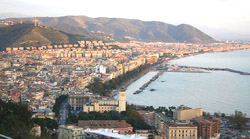
Panoramic view of Salerno |
SALERNO
After the picturesque little towns of the Amalfi, the urban sweep of Salerno and its port along the Bay of Salerno might come as a shock. One of the southern Italy’s many victims of earth tremors and even landslides, Salerno was left in tatters by heavy fighting that followed landings by the American 5th Army just to the south of the city in 1943.
|
With the exception of a mildly charming tumbledown medieval quarter, the city today is largely unexciting. It is , however, an important transport junction and a possible base for exploring the Amalfi coast to the north and Paestum and the Cilento coast to the south. Originally an Etruscan and later a Roman colony, Salerno flourished with the arrival of the Normans in the 11th century. Robert Guiscard made it the capital of his dukedom in 1076 and under his patronage the Scuola Medica Salernitana gained fame as one of medieval Europe’s greatest medical institutes. The city’s cathedral, in Piazza Alfano north of Via dei Mercanti, is dedicated to St Matthew the Evangelist, whose remains were brought to the city in 954 and later buried in the crypt. Flanked by a Romanesque bell tower and an atrium featuring 28 Roman columns, the church was erected by the Normans under Robert Guiscard in the 11th century and remodelled in the 18th century. It sustained severe damage in the 1980 earthquake. The Cappella delle Crociate ( Chapel of the Crusades), so called because crusaders’ weapons were blessed here, is also named after Pope Gregory VII. He lived in exile in Salerno until his death in 1085, and is buried under the altar. The 12th century mosaic and sculptural decoration on the left side of the central nave is among the most eye-catching. A walk to the Castello di Arechi along Via Risorgimento is rewarded with good views. Arechi II, the Lombard duke of Benevento, built the castle over a Byzantine fort. Last renovated by the Spanish in the 16th century, its slow decline has been arrested by modern restoration. The external façade of the cathedral is called “dei Leoni” with an inscription on the architrave of the portal. The atrium consists of a lower ambulatory supported by columns and higher galleries which on the northern and southern sides face the atrium with four fivefold windows divided by a double-window. The small railed gallery on the east in baroque and the three marble statue are by Matteo Bottiglieri (1756). The bell-tower is Roman and consists of five plinths on bases of “travertino”, illuminated by a double-window on the four sides. The tambour is made up of twelve columns supporting wreathed arches. The internal façade has the central portal identical with the other on the external façade and it bears an inscription with a dedication. The bronze door is one of the most important works of the Middle Age: it was cast at Constantinople in 1099 and consists of fifty-four squares, forty-six of which contain a cross and the others figures previously adorned with silver and enamel. The sarcopragi are mostly from the Roman era, between the III and the IV centuries A.D. and were used as tombs for important personages of Salerno. The central nave is famous for its mosaics consisting of the lunette representing St. Mathew on the back of the bronze door, and of the pulpits which have on the bottom fragments of the iconostasis. On the left the Guarna pulpit was rearranged in the XVIII century and rests on four columns with most ornate capitals. On the right the D’Aiello pulpit rectangular in shape, is supported by twelve columns. The crypt preserves the relics of St. Mathew, Apostle and of Saint of Salerno. Originally it was Roman. Its baroque reconstruction underwent three phases; in the first, the double-altar on St. Mathew’s tomb was built by D. Fontana (1607) and the vault was frescoed by B. Corenzio (1643); in the XVIII century the walls were covered with inlaid marble and marble statues by F. Ragonzino of the Medical School of Salerno; recently the double-faced altar has been removed. Of the St. Mathew’s tomb only the tomb-stone is visible. On the altar are two bronze statues by M. Naccherino (1622). The candelabra are a gift from the Medical School of Salerno. In the central apse is the tomb of the Holy Martyrs of Salerno. The bronze statues were done in 1680 by an unknow artist. In the vault, the history of the Holy Martyrs is frescoed by Corenzio. In the left apse the altar-screen is worth noting – Our Lady of Graces by Pacecco De Rosa (1656). In the right apse the frescoes are by Corenzio.
Guided tour on the Amalfi Coast
|